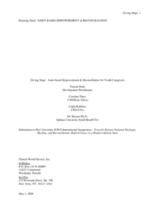As a result of the rising number of children in need of care, Africa’s adolescents and young adults, ages 12-24, have emerged as the heads of their households and the caregivers of their siblings. This paper shares the philosophy and key components of the African development initiative Giving Hope that works with these youth caregivers. The Giving Hope initiative employs an asset-based empowerment methodology to facilitate the restoration of youth caregivers’ sense of self, belonging, power, and collective responsibility. Evidence of the power of this collective responsibility and the development of peace from “within” a community are illustrated by youth caregivers' participation in peace building and reconciliation efforts during the 2008 post-election violence in Kenya. Traditional needs-based perspectives to development and conflict prevention are challenged by the positive results of the asset-based empowerment approach—a renewed sense of community, empowerment, and leadership that comes from within.
The Giving Hope empowerment methodology applies the asset-based approach to the sub-group (community) of youth caregivers. As such, it builds upon the significant strengths that youth caregivers and their households possess by 1) Restoring relationships, structures, and routines in youth caregivers lives; and 2.) Recognizing and reinforcing youth caregivers existing assets (i.e. their existing knowledge, skills, resources, resilience, and newly restored relationships).

